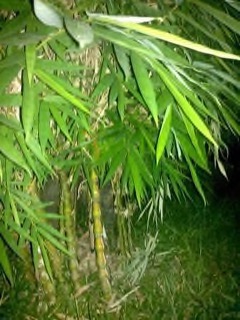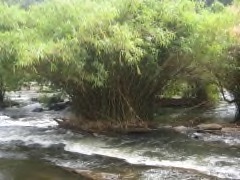 |
|
Sugeesh at Malayalam Wikipedia |
 |
| Shijan Kaakkara Wikipedia |
Translate this page:
Summary
Physical Characteristics

 Ochlandra spp. is a BAMBOO growing to 6 m (19ft) by 3 m (9ft) at a fast rate.
Ochlandra spp. is a BAMBOO growing to 6 m (19ft) by 3 m (9ft) at a fast rate.
See above for USDA hardiness. It is hardy to UK zone 10.
Suitable for: light (sandy), medium (loamy) and heavy (clay) soils. Suitable pH: mildly acid, neutral and basic (mildly alkaline) soils. It can grow in semi-shade (light woodland) or no shade. It prefers moist soil.
UK Hardiness Map
US Hardiness Map
Synonyms
Many. See individual species.
Plant Habitats
Edible Uses
References More on Edible Uses
Medicinal Uses
Plants For A Future can not take any responsibility for any adverse effects from the use of plants. Always seek advice from a professional before using a plant medicinally.
None Known
References More on Medicinal Uses
The Bookshop: Edible Plant Books
Our Latest books on Perennial Plants For Food Forests and Permaculture Gardens in paperback or digital formats.

Edible Tropical Plants
Food Forest Plants for Hotter Conditions: 250+ Plants For Tropical Food Forests & Permaculture Gardens.
More

Edible Temperate Plants
Plants for Your Food Forest: 500 Plants for Temperate Food Forests & Permaculture Gardens.
More

More Books
PFAF have eight books available in paperback and digital formats. Browse the shop for more information.
Shop Now
Other Uses
Fodder
Some species for example Ochlandra travancorica have agroforestry Uses e.g. The plant is often grown along paddy fields, where it acts as a soil binder[317]. The soil under this species in general is dark brown, acidic, sandy loam with granular structure, high porosity, good aggregate stability and with high water holding capacity. A comparison of soil under O. Travancorica with other species from natural forests reveals that this species is very efficient for soil conservation[361]. Other Uses of Ochlandra travancorica include the leaves are used for thatching[317, 361]. The culms are in demand for making mats and baskets, umbrella handles, fishing rods, handicraft, and for making the walls of huts[361]. The mats made from reeds are used for making 'Bamboo ply'[361]. The culms are one of the most important sources of long-fibre raw material for paper pulp[317]. The shoots, when 6 to 9 months old, constitute a splendid paper material[361, 439]. The fibre has been pronounced superior to esparto but the expense of chemicals required in the process make it uneconomic[439]. Carbon Farming Solutions - Industrial Crop: biomass (Crops grown for non-food uses. Industrial crops provide resources in three main categories: materials, chemicals, and energy. Traditional materials include lumber and thatch, paper and cardboard, and textiles) [1-1]. Fodder: bank.
Special Uses
Carbon Farming
References More on Other Uses
Cultivation details
Industrial Crop: Biomass Management: Managed Multistem Regional Crop
Climate: tropical. Humidity: humid. Species include Ochlandra beddomei, Ochlandra ebracteata - India reed bamboo. Ochlandra keralensis. Ochlandra scriptoria - reed bamboo. Ochlandra setigera. Ochlandra sivagiriana. Ochlandra soderstromiana. Ochlandra spirostylis. Ochlandra stridula - Ceylon reed bamboo, Sri Lanka reed bamboo. Ochlandra talbotii. Ochlandra travancorica - elephant bamboo, India reed bamboo. Ochlandra wightii. Carbon Farming Solutions - Cultivation: regional crop. Management: managed multistem (Describes the non-destructive management systems that are used in cultivation) [1-1].
Carbon Farming
-
Industrial Crop: Biomass
Three broad categories: bamboos, resprouting woody plants, and giant grasses. uses include: protein, materials (paper, building materials, fibers, biochar etc.), chemicals (biobased chemicals), energy - biofuels
-
Management: Managed Multistem
Regularly removing some multiple stems. A non-A non-destructive management systems maintaining the soil organic carbon.
-
Regional Crop
These crops have been domesticated and cultivated regionally but have not been adopted elsewhere and are typically not traded globally, Examples in this broad category include perennial cottons and many nuts and staple fruits.
References Carbon Farming Information and Carbon Sequestration Information
Temperature Converter
Type a value in the Celsius field to convert the value to Fahrenheit:
Fahrenheit:
The PFAF Bookshop
Plants For A Future have a number of books available in paperback and digital form. Book titles include Edible Plants, Edible Perennials, Edible Trees,Edible Shrubs, Woodland Gardening, and Temperate Food Forest Plants. Our new book is Food Forest Plants For Hotter Conditions (Tropical and Sub-Tropical).
Shop Now
Plant Propagation
Seed - best sown as soon as they are ripe. They are sown in nursery beds filled with sand and soil mixture in partial shade initially for two months[361]. Seedlings can be transplanted into their permanent positions after a period of one year. Rhizomes can be separated from the culms during the onset of the monsoon and used for field planting. Two-noded culm cuttings of two year old plants treated with NAA or coumarin by cavity method and planted horizontally in nursery beds during summer gives 50 per cent rooting[361]. After one year, the rooted cuttings can be transplanted to the field[361]. During field planting, many plantlets are obtained from the rooted cuttings by separating the sprouts along with the rhizome[361].
Other Names
If available other names are mentioned here
Elephant grass, Ochlandra beddomei, Ochlandra ebracteata - India reed bamboo. Ochlandra keralensis. Ochlandra scriptoria - reed bamboo. Ochlandra setigera. Ochlandra sivagiriana. Ochlandra soderstromiana. Ochlandra spirostylis. Ochlandra stridula - Ceylon reed bamboo, Sri Lanka reed bamboo. Ochlandra talbotii. Ochlandra travancorica - elephant bamboo, India reed bamboo. Ochlandra wightii.
Native Range
Coming Soon
Weed Potential
Right plant wrong place. We are currently updating this section.
Please note that a plant may be invasive in one area but may not in your area so it's worth checking.
None Known
Conservation Status
IUCN Red List of Threatened Plants Status : This taxon has not yet been assessed

Growth: S = slow M = medium F = fast. Soil: L = light (sandy) M = medium H = heavy (clay). pH: A = acid N = neutral B = basic (alkaline). Shade: F = full shade S = semi-shade N = no shade. Moisture: D = dry M = Moist We = wet Wa = water.
Now available:
Food Forest Plants for Mediterranean Conditions
350+ Perennial Plants For Mediterranean and Drier Food Forests and Permaculture Gardens.
[Paperback and eBook]
This is the third in Plants For A Future's series of plant guides for food forests tailored to
specific climate zones. Following volumes on temperate and tropical ecosystems, this book focuses
on species suited to Mediterranean conditions—regions with hot, dry summers and cool, wet winters,
often facing the added challenge of climate change.
Read More
Expert comment
Author
Various
Botanical References
Links / References
For a list of references used on this page please go here
Readers comment
| Add a comment |
|
If you have important information about this plant that may help other users please add a comment or link below. Only comments or links that are felt to be directly relevant to a plant will be included. If you think a comment/link or information contained on this page is inaccurate or misleading we would welcome your feedback at [email protected]. If you have questions about a plant please use the Forum on this website as we do not have the resources to answer questions ourselves.
* Please note: the comments by website users are not necessarily those held by PFAF and may give misleading or inaccurate information.
To leave a comment please Register or login here All comments need to be approved so will not appear immediately.
|
|